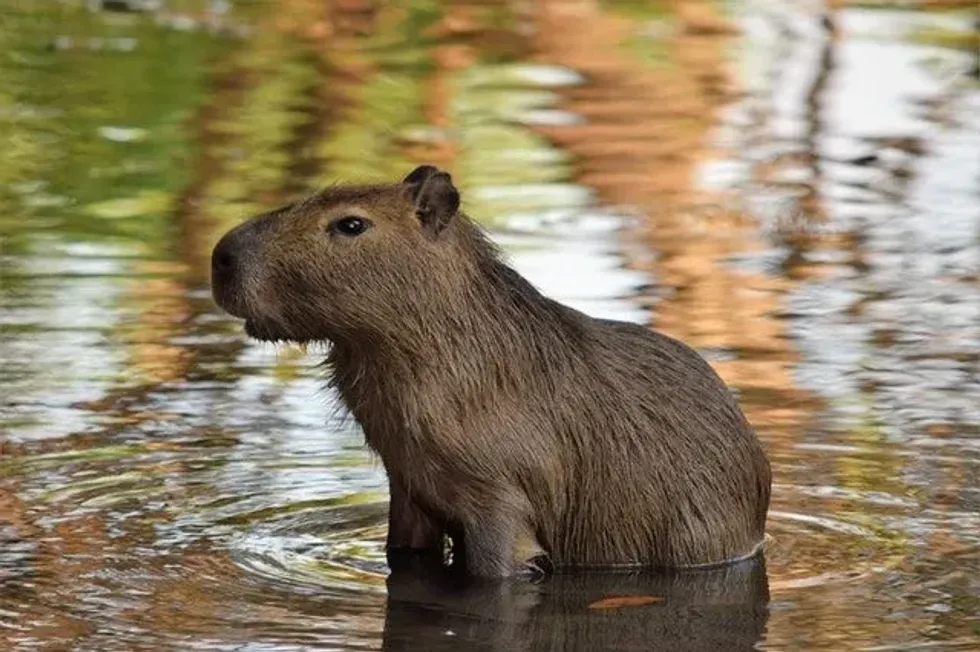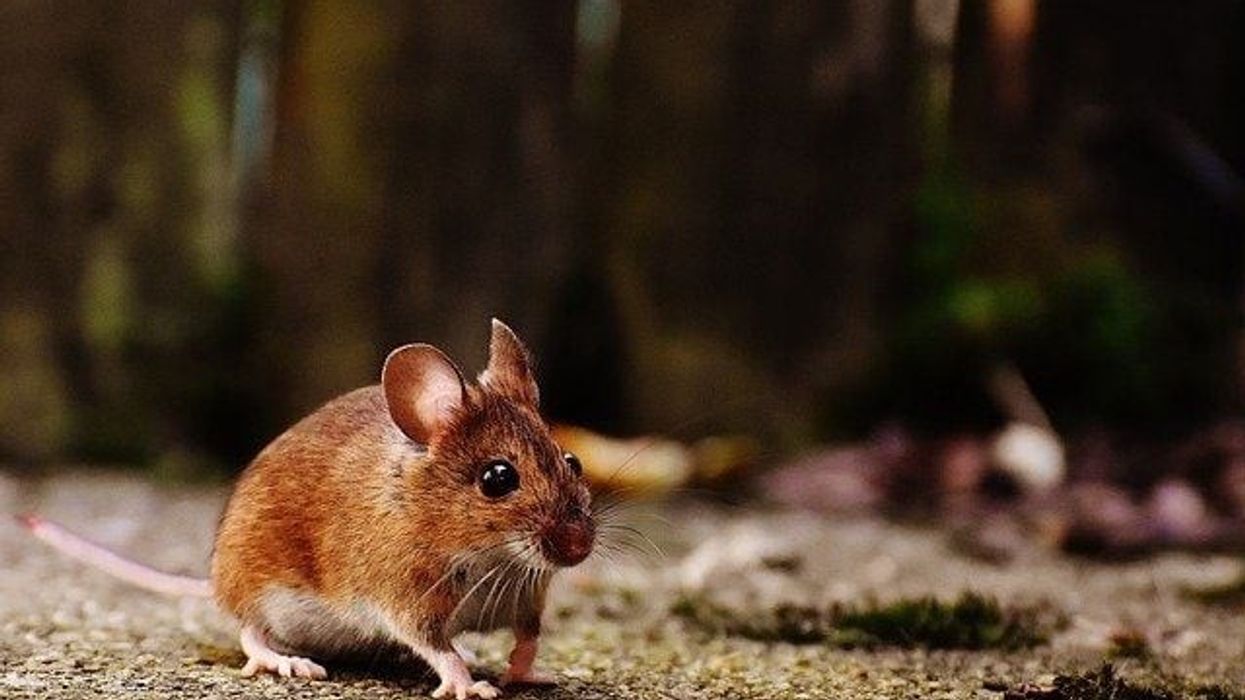Capybara is widely known to be the largest living rodent on earth, almost twice the size of a beaver. Capybaras are found all over the South American continent and are known under different names, such as Capivera in Brazil and Carpincho in Paraguay, Argentine, and Uruguay.
These semi-aquatic rodents are more closely related to guinea pigs. They are found in wetlands and savannas that are located near large bodies of water such as lakes, and marshes.
These rodents are found in abundance and have also been farmed in an effort to ensure that wetlands are protected from their rapid breeding. Being the largest rodent with webbed feet, they are also found in zoos and parks as well.
They are very social semi-aquatic creatures and can be found in groups of approximately 10-20 individuals. They are also referred to as 'nature's ottoman', as other animals love to sit on them and make them bug-free.
Capybaras are hunted for their meat and hide by humans. Their common name means 'Master of the Grasses'.
If you want to read more about them, read on till the end. For more info on animals, take a look at baiji and elephant shrew.
Capybara Interesting Facts
What type of animal is a Capybara?
A Capybara falls under the section of rodents in the animal kingdom. They are considered to be species related to that of Guinea pigs. They are also somewhat distantly related to other species of rodent animals like the agouti, the copy, and the chinchilla.
What class of animal does a Capybara belong to?
Capybaras belong to the class of Mammalia, they are mammals in nature. Their scientific name is Hydrochoerus hydrochaeris. Capybaras also have an extant member known as the lesser Capybara, which in turn is known as Hydrochoerus isthmius. These animals belong to the family Caviidae.
How many Capybaras are there in the world?
Although the exact number is not known, Capybaras are not an endangered species. They are hunted by humans and predators such as jaguars and snakes. Just like other rodents, we cannot determine the exact population of Capybaras.
Where does a Capybara live?
Capybaras are natives of South America. Capybaras are found all over the South American continent and are known under different names, such as Capivera in Brazil and Carpincho in Paraguay, Argentine, and Uruguay. Capybaras have also ended up in places such as Trinidad and Florida. Recently, they were spotted on the central coast of California as well.
What is a Capybara's habitat?
The Capybara habitat is usually found in wetlands and savannas. They are found in forests, especially near large bodies of water such as lakes and rivers. Sometimes these social animals are found in ranches as well.
Who do Capybaras live with?
Capybaras live in social groups of 10-40 individuals where the group is led by one dominant male or more males. Sometimes, they are known to live alone as well, away from the social herds.
How long does a Capybara live?
The average Capybara lifespan is 8-10 years. Capybaras are hunted by humans due to their meat and hide and are eaten by predators, thus shortening their life span to 4-7 years. In captivity, they have been observed to live for as long as 12 years.
How do they reproduce?
Capybaras are mammals, reproducing 1-8 pups in a single litter. The average gestation period is 130-150 days. They mate in water, and birth is given on land. The female usually rejoins the group within a few hours after giving birth. One dominant male will fight with another dominant male to gain the right to mate.
What is their conservation status?
Capybaras are found in abundance in the South American continent. As per the International Union for Conservation of Nature (IUCN) and their Red List, they fall under the category of Least Concern.
Capybara Fun Facts
What do Capybaras look like?
A capybara looks like a ginny pig. They are usually 24 in tall till the shoulders. They are known to have a body that is shaped like a small barrel. Along with these, they have long hind legs, small eyes and ears, and little noses.
The exceptional web-like feet make them exceptional swimmers. The color of their fur is red while turning yellowish on the underside. The fur has a tinge of brown throughout.
How cute are they?
Capybaras are relatives of guinea pigs. Even their scientific name, Hydrochoerus, comes from the Latin of the word 'water hog'. They are adorably cute and furry creatures with barrel-shaped bodies, small eyes, and little noses. They look like a bigger version of guinea pigs, and they are very cute.
How do they communicate?
Capybaras usually communicate with a combination of scent and sound. Their usual mode of communication is grunts and squeals. Capybaras are very vocal creatures.
They have two scent glands. While one is located at the rear of their body, the is located at the nose and is called the Morillo. Males also have a habit of marking their territories by urinating on them, although females are not seen exhibiting this behavior.
How big is a Capybara?
Capybara is the largest rodent in the world. An adult of these rodents can measure between 3.48-4.40 ft in length. In regards to height, they usually measure between 20-24 in. They are twice the size of a common beaver.
How fast can a Capybara move?
Capybaras are known to be excellent swimmers in water. They have webbed feet, which allow them to swim very fast in the water.
What also adds to their fast swimming speed is the fact they can hold their breath under the water for a fairly long time. Apart from being fast in the water, they have quite fast on land too. Owing to their agile nature, Capybaras are known to run up to a speed of around 22 mph.
How much does a Capybara weigh?
The weight of the Capybara depends on the gender of the animal. The average weight of a male Capybara is between 77-146 lb, with an average of 108 lb. Females usually weigh more than males and exhibit sexual dimorphism to an extent. The weight of the heaviest Capybara ever recorded is 201 lb female from Brazil.
What are their male and female names of the species?
There are no specific names for Capybara males and females. All males and females of this species are simply known as Capybaras.
What would you call a baby Capybara?
Capybara babies do not have any specific names attached to them. When they are born, they can be called 'Capybara pups'.
What do they eat?
Capybaras are herbivores in nature. A typical capybara diet usually consists of grasses, aquatic trees, and barks. Capybaras are very selective feeders. They like to eat the leaves of one tree, but they might not consume the bark of the tree.
They eat a greater variety of plants, grasses, and reeds in the dry season. During the wet season, they mostly consume grass. An adult Capybara has been observed to eat anywhere between 6-8 lb of fresh grass per day.
Are they dangerous?
As an animal, they are not dangerous. The only thing dangerous about Capybaras is that they have sharp teeth for chewing tree barks and plants. They are not even carnivores, for that matter.
Would they make a good pet?
Capybaras can make for good pets when kept in groups. However, to care for a Capybara as a pet will never be as easy as caring for their close relatives, the guinea pig.
Yet, they are known for their friendly nature, and, once habituated, a Capybara with other animals can have a high rate of compatibility. But, larger pets like breeds of game dogs should be properly trained to be near Capybaras as they might be chased and killed by these dogs.
Did you know...
Capybaras are known for unusual habits in their diet, like eating their own poop in the morning. That is because it is protein-rich in nature, and the kind of grass and plants eaten by the Capybaras can be difficult to digest in one go.
Thus, the poop that is excreted actually still has essential nutrients from the grass in them. In eating their own poop as food, they digest these essential macronutrients twice. This is a major part of their survival.
Capybaras can hold their breath under the water for as long as five minutes!
The 2 peso coin of Uruguay has the image of a Capybara on it!
In a manner similar to some of the other South American rodents, their teeth never stop growing! In order to keep the growth rate of the teeth in check, the Capybara has to wear them down by grinding and chewing on food, plants, or tree bark as part of their diet.
Their molar teeth keep growing all their life, but they also wear down due to the mastication of the green food they eat!
A Capybara has three and four toes on its rear and front feet, respectively.
How does a Capybara protect itself?
Small and furry Capybaras do not have many weapons in their arsenal for their own protection. They are fast swimmers because of their web-like feet, and they can hold their breath underwater for a long time.
When attacked by land predators, a capybara jumps into the water and hides beneath the surface. Sometimes, when aquatic anacondas attack in the river water, they may be fortunate enough to make an escape by swimming away from these snake predators.
Also, Capybaras are very vocal creatures. They can bark like dogs when faced with danger.
What sound does a Capybara make?
Capybaras usually communicate with sounds such as a purr or grunt or squeal. When in danger, they bark to scare their predator away. During mating, a female makes a whistling sound through her nostrils.
How to pronounce Capybara
Capybara can be easily pronounced this way: kah-puh-baa-ruh!
Here at Kidadl, we have carefully created lots of interesting family-friendly animal facts for everyone to discover! Learn more about some other mammals including pine marten, or rock hyrax.
You can even occupy yourself at home by drawing one on our Capybara coloring pages.










